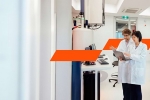Global business leaders are rightly preoccupied with tariffs, trade and geopolitics. Uncertainties about market access, input costs and supply chain viability pose big questions about near-term company performance. They also hold an additional danger: the potential to take over the top management agenda, overshadowing forces that will have an enormous long-term impact and that need attention now.
Our aim in this article, which builds on multiple PwC research efforts and untold thousands of hours of working together with our clients, is to provide an antidote: a simple, rigorously substantiated guide that helps leaders navigate the value in motion in the global economy. The starting point is understanding what’s really going on, which is actually pretty straightforward.
Three massive discontinuities are taking place simultaneously. One of them—the fracturing of the post–Cold War geopolitical order—is making headlines every day. The other two are deep economic shifts that are already reshaping the global growth environment: artificial intelligence and physical climate risk. AI is creating the potential for a productivity revolution to supercharge growth. Simultaneously, the rising frequency of flooding, drought, heat stress, wildfires and other physical climate risks is about to impact some of our baseline assumptions about economic growth. This article focuses primarily on these economic changes, which are a big deal for global business leaders. Despite all the net-zero pledges, despite the Business Roundtable’s revised Statement on the Purpose of a Corporation, despite principled withdrawals from Russia following its Ukraine invasion, growth remains one of the most, if not the most, important priorities and performance metrics for CEOs everywhere.
Innovation is catalysed by both opportunities and constraints. And it will emerge as AI and climate change interact with each other and with other advanced technologies, with fracturing geopolitics, and with other megatrends such as ageing populations and social inequality. The magnitude of the forces at work will spur fundamental innovations in business, operating and energy models. Taken together, these forces hold the potential to reconfigure the global industrial system into what we’ve begun calling new domains of growth: zones of economic activity and value creation, where companies collaborate in imaginative ways to meet human needs.
Enormous amounts of value will be in motion within and across these domains, creating both exciting growth opportunities and significant uncertainties. These will directly influence the shape of the domains and, ultimately, whether the world becomes a more or less prosperous place. Over the past 12 months, PwC has sought to quantify the impact of all this on the global economy of 2035. That time frame is highly relevant for today’s leaders, because the decisions and actions they take now will shape the outcomes of the next ten years, even though that time frame is beyond the typical detailed planning horizon.
What’s the real productivity potential of AI? How does it compare to the costs of physical climate risk, and of transitioning to a lower-carbon future? What’s the scale and scope of the domains forming around how we move, feed ourselves, build and make things, care for ourselves and others, and fuel and power society? How do we fund and insure, connect and compute, and govern and serve to enable industry reconfiguration? The answers to all these questions lie at the heart of the future leaders must navigate. By creating an integrated economic fact base and using it to inform three plausible scenarios for growth, we’ve sought to quantify the uncertainty facing leaders. Doing so provides a useful alternative to the hyperbole and guesswork that too often characterise conversations about the future.
Our research shows that the global economy could be nearly 15% bigger than expected in 2035 if AI delivers a jolt to productivity comparable to the productivity booms ignited in the past by foundational technologies like electricity. Such gains would depend on the fundamental rewiring of functions and tasks in organisations, which will come about only if the AI really works, it’s responsibly deployed, and it’s therefore deeply trusted. The AI growth dividend also depends in part on the global economy replacing the tasks AI takes over with new ones for people to perform.
AI will also require a lot of electricity. Happily, analysis undertaken by PwC experts (see ‘Could net-zero AI become reality?’) suggests that over time, the additional energy required by data centres for expanded AI adoption and productivity growth could be offset by AI-identified energy-efficiency opportunities in the rest of the economy. That said, AI-driven productivity benefits are far from certain. Under less optimistic adoption and task creation scenarios, the AI dividend could drop—to 8%, or even 1%.
Securing a sizeable AI dividend could counteract a range of economic challenges associated with climate change. The estimated toll of Los Angeles’s January wildfires—US$250 billion and counting—is a timely sign that climate-linked events are imposing rising economic costs. Over the next decade, the trajectory of those costs won’t depend on near-term emissions, according to detailed analysis by PwC economists and climate-risk modelling experts. Recent academic research from the Potsdam Institute for Climate Impact Research in Germany reaches similar conclusions. Integration of that external research with PwC’s economic modelling suggests physical climate costs could make the global economy nearly 7% smaller in 2035 than it would be in the baseline, ‘business-as-usual’ model.
Looking out further than 2035, the economic impact of physical climate risk could fall with more aggressive decarbonisation—which also has costs: PwC analysis shows that the economic cost of assets written off, or ‘stranded,’ by decarbonisation efforts could exceed 3% of global GDP by 2035. Given the magnitude of change required for simultaneous, large-scale decarbonisation and productivity growth from AI, we describe this scenario as a Trust-Based Transformation. Other outcomes are also possible—like a Tense Transition, in which a smaller AI dividend is largely cancelled out by climate costs, or Turbulent Times, where growth dips as tech disappoints and sustainability efforts fall by the wayside. Which scenario actually comes to pass will depend partly on the direct, collective actions of business leaders, and partly on the geopolitical forces they will be reacting to and, over time, can help shape.
These growth dynamics, and the magnitude of the value at stake, mean that companies will have to innovate their business, operating and energy models rapidly. They’ll also need to compete in new ways on technology, on trust and for sources of scarce supply. And they’ll need new playbooks for transforming obstacles into enablers of change: by unblocking leaders and resources, acquiring critical capabilities, and reappraising tax and regulatory strategies. (For a more detailed description of these moves, see ‘Reinventing your company for growth.’) To take bold action, leaders will have to adopt fresh mindsets: embracing uncertainty to make smart choices about where and how to compete; taking a big-picture view of the forces at work and bringing it into the top management agenda; and thinking exponentially about the possibilities before us. Leaders able to think and act in these ways have an opportunity not just to thrive in any scenario but to tip the scales towards more promising global outcomes that will boost growth, safeguard the future of the planet, and make life better for citizens today and for future generations.
Domains of growth
To understand why it’s plausible for new domains of growth to take shape today, let’s go back to the formation of our industrial system, which took place in a relatively short period of time in the mid- to late-19th century. Alfred Chandler, the Harvard Business School historian who brought rigour to the emergence of managerial capitalism in books such as The Visible Hand, carefully defined the underlying forces at work: a ‘revolution in transportation and communication’ and a ‘revolution in distribution and production’ took place as the application of energy—first coal, then oil, gas and electricity—to business activities generated a wide range of process, product and service innovations.
These 19th-century ‘revolutions’ were serious economic changes: before them, productivity and economic growth were slow. Afterwards, they rose steadily. Before them, companies were small. Afterwards, they became large and professionally managed, necessitating managerial advancements such as the organisation chart, modern accounting practices and the multidivisional company. Before them, industries such as the railroads, consumer packaged goods, department stores and vertically integrated steel and oil production did not exist. Afterwards, they did—and still do, along with their offspring, such as aircraft, cars, chemicals and pharmaceuticals.
Changes ahead
Economic shifts like the ones that gave rise to today’s industrial system are infrequent—they happen maybe once in a century, not once in a decade. Yet we are standing on the cusp of two.
AI-fuelled productivity growth
The exponential growth in AI capabilities is creating the potential for an intelligence revolution that could be as significant as the physical one unleashed in the 1700s by the advent of the steam engine, and extended by the 19th-century revolutions in transportation, communication, distribution and production.
There has never been a cognitive productivity tool like AI, and we’re only beginning to see what it can do. When you receive a summary of a video meeting, moments after it ends, with no human intervention, you’re seeing a mundane but useful example. The AI bot embedded in your meeting software just saved a colleague 20 minutes or so. Multiply those savings times tens of millions of meetings every day, and you free up millions of hours that can be put to better use.
But that’s just scratching the surface. Coming soon: AI ‘agents,’ instructed and supervised by humans, to handle routine customer inquiries, produce first drafts of software code and turn human-powered design ideas into prototypes. Already, Unilever’s legal team is using the company’s AI systems to boost efficiency, streamline work and reduce reliance on external service providers for contract drafting, compliance audits and IP-related issues. Similarly, Samsung uses AI chatbots for customer service across its product lines, including mobile devices and home appliances. These bots help answer questions and provide technical support. SoftBank is using AI tools to help develop new technology by creating prototype models from ideas provided by humans.
Then, consider the way all these different technologies interact with one another. AI may prove an amplifier and an accelerant of other new technologies, including biotechnology and advanced sensors, and smart materials. For instance, AI’s ability to analyse large amounts of data, make predictions and automate tasks holds the potential to dramatically enhance drug discovery, diagnostics, energy efficiency, predictive maintenance in manufacturing, quality control processes, robotics, traffic and logistics optimisation, and much more. Japan’s Yaskawa Electric, for example, uses AI in combination with robotics technologies to enhance the capabilities of its industrial robots. AI enables more precise and adaptive manufacturing processes, improving automation and efficiency in production environments. The State Grid Corporation of China (SGCC), one of the world’s largest utility companies, uses AI alongside smart grids to better analyse and predict energy consumption patterns and to balance power supply from multiple sources.
What we’re talking about is an AI-driven improvement in how resources like workers, machines and materials are used together to produce things. There’s a healthy debate underway about the pace and extent of economic impact that AI will generate. How big could it be? PwC economists defined an upper bound by bringing AI adoption estimates, along with an associated productivity ‘uplift’ coefficient derived from recent academic research, into their general equilibrium model. They found that a positive AI ‘shock’ of this magnitude could boost 2035 real global GDP by nearly 15% over ‘no-shock’ estimates. That’s more than 1 percentage point of incremental growth per year—on par with the growth increment the world began enjoying with 19th-century industrialisation. However, we’d be the first to acknowledge that this is a thought experiment, not a forecast.
Climate constraints
There’s a counterweight to the AI-fuelled productivity dividend: the carbon-intensive growth model that has long fuelled global development has changed the climate in ways that are starting to affect economic health.
Just as an instant meeting summary brings the productivity potential of AI to life, the rising frequency and severity of cyclones, droughts, floods, heatwaves, hurricanes, tornadoes and wildfires make physical climate risk extremely real. So do the hundreds of billions in climate-related losses reported by insurance companies, despite rapidly rising rates in risky geographies, and isolated examples of climate-related corporate distress like the bankruptcy of Pacific Gas and Electric (PG&E) following the 2018 Camp Fire in Northern California.
PwC climate experts and economists sought to quantify the magnitude of that impact. For example, we looked at the productivity impact of heat stress, the impact of warming on arable land and the impact of factors like these on economic growth under different emissions scenarios to 2035. One inescapable conclusion was that there isn’t much we can do to affect the climate-related damage the planet experiences over the next ten years: the results of our analysis were nearly identical regardless of what emissions pathway we modelled. A second was that it is devilishly difficult to translate quite granular, local climate risk possibilities into systematic global macroeconomic results. Simply put, we weren’t able to capture a full economic picture through the aggregation of disconnected, bottoms-up results.
Academic researchers have been labouring to quantify more precisely the wide range of climate hazards and macroeconomic transmission mechanisms. One recent study by researchers at the Potsdam Institute, whose methodology and data are still under review, was incorporated late last year into the forward-looking scenarios of the Network for Greening the Financial System (NGFS), a consortium of more than 100 central banks and financial supervisors. We followed the NGFS’s lead to create a conservative baseline for economic growth. Without this adjustment, and without an AI-driven productivity dividend, PwC economists anticipated real global GDP in 2035 to be about 33% larger than it is today. With the climate damage adjustment, that figure drops to roughly 26%.
Innovation and industry reconfiguration
To briefly recap: AI capabilities—on their own and in combination with other emerging advanced technologies—create enormous new possibilities for innovation, productivity growth and economic uplift. Simultaneously, physical climate risk will soon impose meaningful, new economic constraints. The way those forces come together will create an impetus for change that we believe will reconfigure the global industrial system. That bold claim rests not just on AI and climate risk, but also on the fact that they will interact with other forces in demand, supply and the potential for companies to meet human needs through broader and deeper ecosystem collaboration.
Demand
As powerful megatrends propel the global economy, preferences are evolving and consumers are demanding new value propositions. Ageing societies and increasing income inequality, for example, are giving rise to needs for in-home services and delivery; concierge healthcare; and ‘barbell’-shaped product, brand and pricing architectures. Simultaneously, AI is enabling faster, deeper data analysis, as well as enhanced design, rapid prototyping and testing. The Japanese technology company Teijin, for example, uses AI algorithms to analyse large volumes of data, including historical sales data, market trends and customer feedback. These algorithms identify patterns and correlations that might not be immediately apparent to human analysts. Machine learning models then help the company to better predict demand patterns and optimise inventory levels. Coca-Cola, meanwhile, is using TensorFlow, an open-source machine learning development platform, to analyse large datasets, derive insights and improve marketing strategies. Customers will expect greater variety, customisation and quality as a result.
Heightened climate concerns are creating additional pressures. A 2024 PwC survey found that global consumers are ready to pay extra to support sustainability—as high as 9.7% more for sustainably produced or sourced goods. As physical climate risk imposes growing costs in the years ahead, it’s easy to imagine further impetus for new value propositions, because consumers increasingly will recognise connections among human behaviour, climate risk, and macro and personal economic outcomes.
Supply
Creating new customer value propositions amid tricky cross-currents will increase stress on organisations. Geopolitical fragmentation is challenging the global value-creation system in which today’s business leaders grew up. Potential consequences include market disruption, broken value chains, and reduced access to scarce materials such as copper and lithium for companies in some regions. Ageing populations in most western economies and much of East Asia are driving skills shortages, boosting costs, and creating a need for organisational and operational innovation to make better use of technology. And physical climate risk is disrupting supply chains and increasing production costs.
Few companies have all the capabilities they need to respond to these forces. Fortunately, they don’t have to. Digitisation has been reducing transaction costs, enabling companies to integrate with customers and suppliers, blurring traditional sector boundaries, and giving rise to new business models. Those dynamics brought us ride-sharing, peer-to-peer property rental, and other disruptive propositions, and they hold great potential for large, existing organisations that seek to compete more effectively by borrowing the capabilities of partners.
AI can further reduce the cost of interacting with other organisations—decreasing search and information costs, analysing historical pricing data to streamline negotiations, facilitating scheduling and communications, and monitoring compliance and agreements. Consider, for example, the potential of AI to simplify real-time data and insight exchanges between drug companies and regulators, enabling even more targeted discovery efforts and reducing late-stage surprises. Or the global retailer using AI to speed decision-making and reduce downtime in its supply chain operations, which is smoothing interactions with a wide range of ecosystem partners. Not flashy, but it can be an invaluable tool for collaborative effectiveness.
Domains of human need
Delivering new value propositions creates a growing need for companies to evolve their value-creation models, often in collaboration with organisations from far-flung industries. What does this look like in practice? Consider the bustle of activity as carmakers, battery innovators, tech players, charging station operators, and many others develop electric vehicles and their supporting infrastructure. Dozens of partnerships and other arrangements are bringing disparate players together to serve changing customer needs. By drawing on the immense power of collaborative ecosystems, these companies are accomplishing things together they never could alone.
Now zoom out, and you can see a constellation of players trying to serve a basic human need: how we move. At a time of uncertainty and transition, focusing on basic needs is quite clarifying. What customers want, need, expect and prefer—and how companies, along and with others, meet those needs—is changing in difficult-to-predict ways. But the basic human needs—food, shelter, healthcare, mobility, affordable goods—remain. So does the need for energy, funding, connectivity and computing power, and governance so our industrial system can meet these needs.
Focusing on human needs is a different way of looking at our industrial system. It organises that system into broader and deeper value pools (‘domains’) in which companies meet human needs by combining their own capabilities with, and engaging with, ecosystem partners in new ways. Those new value pools will reward heightened specialisation with new technology combinations that create positive feedback cycles as well as products and services that weren’t previously possible. Aerobotics, a precision-farming innovator based in South Africa, has integrated a new array of tools and capabilities: namely, drones, cameras, polymers, brushless motors, communications infrastructure, software, AI pattern recognition, machine vision, data analytics, knowledge about when fruit is ripe, and the ability to differentiate between pests and harmless insects. This combination of necessary technology has now surpassed a threshold of economic viability, and low transaction costs have enabled Aerobotics to assemble a new value proposition.
We bring this view to life analytically by mapping traditional economic sectors today (on the left side of the chart below) to those core human needs (on the right), scaled up to 2035.
This simplified graphic suggests just how much value will be in motion amid the large-scale reconfiguration underway. Because these domains bring together a wide range of economic sectors, they are naturally larger than the traditional sectors and create new growth opportunities for a wide range of companies within and across them. That is why we call them domains of growth.
Opportunities and uncertainties
The fragmenting and recombining lines in the chart speak to two fundamental realities at the heart of industry reconfiguration. First, opportunities. Industries and companies don’t change for the sake of change. They evolve as new market dynamics alter the set of available opportunities, as leaders invent and seize new possibilities, and as competitors respond with moves of their own. Second, uncertainty. Massive as the impetus for reconfiguration is, its pace and extent, particularly over the next decade, is uncertain. We’ve tried to capture the implications of that uncertainty by developing three divergent scenarios for future growth.
Opportunities within and across domains
To understand what could happen within domains, consider how we build: As technology creates new opportunities to construct and operate buildings more efficiently, traditional activities such as real estate, construction, and building management will be joined by innovation spaces such as smart, sustainable buildings; build tech and data; and smart city infrastructure. For example, IKEA, the Swedish housewares manufacturer and retailer, has ventured into urban planning and smart city solutions through initiatives underpinned by AI-enabled data insights, generative design algorithms, and predictive analytics. PwC research suggests that a decade from now, this grouping of activities could represent US$14 trillion in value added to global GDP.
The domains also hold tremendous potential for companies in sectors such as financial services and telecommunications, whose businesses cut across and enable all of them. The telecommunications sector offers a series of compelling possibilities, such as providing traffic management systems and the related communications infrastructure for smart cities (how we move), making plays in wearable devices and telehealth services (how we care), creating connectivity to authenticate the provenance of the food supply with blockchain technologies (how we feed), providing real-time data and analytics from connected buildings (how we build), or scaling cross-border smart grid systems that facilitate regional energy sharing and trading (how we fuel and power).
Economic uncertainties
Exciting as all this sounds, there’s quite some distance between the industries of today and the domains of tomorrow. As our colleagues described in a recent strategy+business article, a multitude of factors—including massive investment needs, interdependencies among thousands of players, missing regulations, slow technology adoption, reluctance to abandon legacy assets and massive investment requirements to replace them—could slow the pace of change. Although these factors are far too diverse and complex to measure across the global economy, we undertook to create economic proxies for the wide range of uncertainties at play, in two ways.
AI uncertainties
Artificial intelligence is only part of the industry reconfiguration story. Still, if AI fails to deliver a positive productivity shock, the range of possibilities for innovation and growth will diminish, reducing the pace and extent of domain formation.
A critical variable is whether leaders and companies trust it enough that they become comfortable fundamentally rewiring the functions and tasks of their organisations. That trust will rest both on how well the AI works and on the responsibility with which it is being harnessed within and outside company walls. For AI to disappoint, it doesn’t need to run amok or take control of humanity. Rather, it comes down to whether leaders conclude that the risks of deep integration in the core of the business outweigh the likely productivity benefits. In addition, there’s the critical question of what leaders and organisations do with the productivity gains, whatever their size, made possible by AI. In economic terms, it’s a matter of whether the business innovation sparked by AI creates more new tasks for people to perform than the number of tasks it destroys.
Decisions and actions by thousands of individual leaders, their organisations, policy-makers and standard setters will shape the direction of travel. We sought to capture this variability in our economic modelling in two ways. One was by varying assumptions about the productivity impacts of AI adoption. The other was by varying assumptions about task creation as AI takes on tasks currently performed by people.
Climate uncertainties
Climate change brings two critical uncertainties to the decade ahead. One is the magnitude of economic cost associated with physical climate change. The other is our response: will the growing economic cost of physical climate risk cause business and government leaders to decarbonise more aggressively? Or will we enter a vicious cycle in which the growing costs of climate damage undermine our capacity to fund the decarbonisation that would create more favourable future economic conditions? Time will tell.
What we can do today is to understand the economics of those choices. In a previous, separate research effort, PwC highlighted the large gaps between existing technologies, infrastructure and investment—and the higher levels needed for rapid, large-scale decarbonisation. (For example, annual clean energy investment would have to rise substantially from US$1.8 trillion in 2023 to US$4.6 trillion in 2030, according to International Energy Agency estimates.)
The flip side of uncertainty around the bridging of that gap is uncertainty about the writing off, or ‘stranding,’ of assets replaced by those new investments. PwC climate change experts translated data from market-standard climate transition scenarios (principally from the NGFS and the International Energy Agency) into a range of possibilities about renewable energy ratios, prices for fossil versus renewable energy sources, and stranded assets over the decade ahead. Our economists then brought this data into their general equilibrium model. This enabled them to estimate the cost under different decarbonisation scenarios of retiring carbon-intensive assets used for activities such as electricity generation, manufacturing and mining. The general equilibrium model used by our economists assumes that any stranded assets would be replaced by less-carbon-intensive ones, creating puts and takes in terms of sector-level investment, consumption, and output for different scenarios.
Three tomorrows
Over the decade ahead, the uncertainties we’ve just described will collide and interact with other major forces at work to shape the growth environment. Although a wide range of outcomes is possible, we’ve focused on three scenarios to bring the future to life. These scenarios differ from many that abound in management writing, techno-forecasting, climate science and works of fiction because they only go out to 2035. That’s not enough time for, say, an eco-tech-utopia to emerge, or for acrid skies and flood zones to dominate the landscape.
But we will build momentum, in the next ten years, towards one of those outcomes—with significant implications for the operating environment facing global business leaders. Each scenario is based on different assumptions about the key AI and climate variables fuelling our economic modelling efforts. All of the scenarios can be compared against a baseline projection that assumes a ‘business as usual’ approach, in which historical economic trends continue without significant deviations, over the next decade. The results are not predictions of the future; they are simply a means of analysing the potential impact of those varied assumptions on future economic performance.
Trust-Based Transformation
In this scenario, the integration and responsible use of advanced technologies enables widespread productivity growth and task creation while supporting sustainable solutions and innovation. Frameworks for trust (including global standards and cooperation) would be part of this picture. The economic benefits of AI would significantly exceed the stranded assets costs associated with ambitious decarbonisation, leading to growth rates higher than our baseline expectations for economic growth, even adjusting for climate-related economic damages.
Tense Transition
It’s easy to imagine a world where national and regional interests take centre stage; where sustainability efforts are restrained; and where technology is more fragmented, less trusted, and less able to deliver on the productivity potential of AI. Growth would be status quo at best, with AI gains nearly offset by the costs of physical climate change. The energy transition would proceed more slowly, stranding fewer assets in the near term and setting the stage for larger physical climate risks in the future.
Turbulent Times
The third scenario assumes a future of atomised (local and individual) interests, disruptive and divisive technology, and suspended sustainability efforts. Conflicts, instability and heightening uncertainty could conspire to diminish trust in technology and the economic benefits it generates; to create tasks more slowly than they are automated away, reducing employment; and to neglect sustainability measures at the cost of the future. Tensions over free or fair trade continue to fracture geopolitical alignments and hinder international collaboration. Growth in this scenario could dip below the baseline expectations.
In the near-term, tariffs and rising geopolitical tensions seem to be taking us further from a trust-based world. Perhaps, though, the longer-term economic advantages of working together will cause the pendulum to swing back. And although it’s impossible to know now which tomorrow will emerge, the uncertain future in no way diminishes the importance of the new domains of growth. As Ilya Prigogine, the Belgian chemist who studied chaos in the physical world, famously said, ‘Uncertainty is at the very heart of human creativity.’ Indeed, today’s uncertainty is pushing all of us, as individuals and organisations, to explore exactly the types of new ideas and solutions that are at the heart of the domains.
The reinvention agenda
To prepare for any of the three tomorrows, leaders should get ready now by creating a holistic agenda for innovation, competitive advantage and removing obstacles to reinvention. Many will also need to expand their perspective to embrace uncertainty, take a systems view of the forces at work and think exponentially about the possibilities ahead.
Priorities for continual reinvention
System-wide change is underway, and that means companies need to become as dynamic as the forces at work around them. In practical terms, this means three things. First is igniting innovation in their business, operating and energy models. Second is mastering emerging sources of advantage by competing in new ways on technology, on trust, and for scarce supply. Third is addressing blockers of reinvention, which often founders on the shoals of inertia, capability gaps, decision-making breakdowns, or mismatches between business goals and regulatory realities. Transforming obstacles like these into enablers such as capability-driven deals, well-aligned tax and regulatory strategies, empowered leaders, and entrepreneurial organisations will help determine the pace and extent of change for companies, industries and society. In a companion article, ‘Reinventing your company for growth,’ we’ve described in more detail how to tackle these priorities, illustrated by examples of companies who have already embarked on the journey.
Effective action plans begin with a realistic assessment of a company’s current state. Because companies perform progressively—today’s performance provides the foundation for tomorrow’s—some companies will be better positioned than others to thrive in new growth domains. For example, until lagging companies modernise their data and address their technical debt, they won’t be able to make full use of AI, and they’ll struggle to thrive in emerging business ecosystems. The upshot: companies that are behind now are likely to be further behind later—regardless of where they choose to compete—unless they have a plan to remediate, then reinvent.
Mindsets for a prosperous future
To act differently, leaders also need to think differently about uncertainty, the interrelated forces at work and the exponential possibilities ahead.
Embrace uncertainty
Leaders hoping to nurture, build and scale ideas and solutions need to navigate uncertainty effectively so they can achieve economies of scale and scope, and make good choices about where to compete. The size of the domains, magnitude of opportunity within them, and pace of innovation will be influenced by the scenario that takes shape over the decade ahead. It’s always easier to carve a big slice of a larger pie. Strategic participation in domains of growth will become even more important in less favourable scenarios, because players who see beyond traditional industry and sector lines will be more likely to identify ways to leverage and integrate their capabilities to gain economies of scope and grab growth opportunities.
At the same time, the attractiveness of specific opportunities will vary based on the future we choose. Looking again at ‘how we build,’ it’s easier to imagine, say, real-time data gathering and analysis from networks of connected buildings in a world of Trust-Based Transformation; or to see the merit of specialised insurance products to cover risks of building damage due to social instability and cyberattacks in Turbulent Times. There also are likely to be no-regrets moves for multiple scenarios, such as the pursuit of building material recycling and intelligent lighting systems. To illustrate these and other possibilities, we’ve mapped a broader set of forward-looking opportunities against different states of the world for ‘how we build’ below. An immersive digital experience maps opportunities for all of the domains.
Geopolitical uncertainties, with their implications for global business strategies and for the attractiveness of pursuing market opportunities or conducting business activities in different regions, are an increasingly important element of these dynamics.
Take a big-picture view
Leaders who understand the mutually reinforcing nature of the forces at work today will be better positioned to navigate the dynamic systems they are part of. They’ll recognise, for example, that AI and other advanced technologies are broadening and deepening the potential for business and operating model innovation, both of which will drive industry reconfiguration and put value in motion. They’ll understand the need to support AI advances and transformations in mobility, manufacturing and power with investments in energy grids, energy storage and hydrogen grids, not to mention the use of carbon capture and storage. They’ll also see that climate risks are heightening the competition for scarce global resources and elevating the importance of energy innovation, both of which are reinforcing the transformation of business models, operating models and industry restructuring. And they’ll appreciate that feedback loops abound, with business and operating model opportunities stimulating further technology innovation; energy and supply chain innovation boosting climate resilience; and industry reconfiguration accelerating the spreading of product, process and service innovation from leaders to fast followers.
Think exponentially
It’s often been said that one of the great frailties of the human mind is the inability to understand the exponential function. This is a time for leaders to stretch themselves and their management teams to break through that limitation. Doing so is crucial, because there are exponential qualities associated with both AI and its interaction with other advanced technologies, and with the possibility that climate risks will compound in a nonlinear fashion. Industry reconfiguration will reflect both of these effects, making an exponential mindset invaluable for leaders hoping to gain an advantage on competitors.
An exponential mindset also puts us in a position to recognise that we may be having the wrong debates about the future we are creating. The question isn’t whether we can generate enough clean energy to power AI. It’s how to scale and leverage AI to boost energy efficiency in the economy as a whole. It’s not about whether we can afford to decarbonise, but about how to channel the productivity and growth dividend associated with AI into investments today that reduce costly climate risks in the future. And it isn’t about scarcity and zero-sum gains. It’s about working together to enable win-win breakthroughs, within and across domains, that create a more prosperous future.
The leader’s guide to value in motion
Reinventing your company for growth
A decade of value in motion awaits, marked by innovation and industry reconfiguration. Seize the moment to extend your lead—or to catch up to rivals.
Value in motion
AI, climate change and geopolitical shifts are reconfiguring the global economy. We’ve mapped where value is moving over the next decade, so you can build a future-ready business to capture it.


















